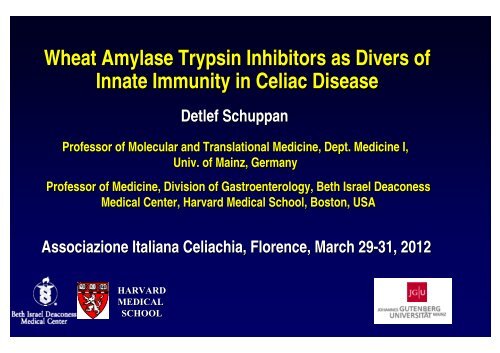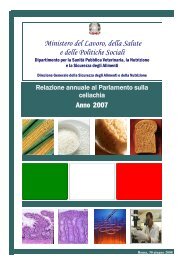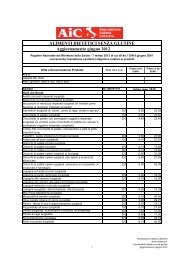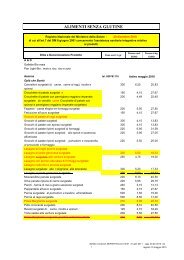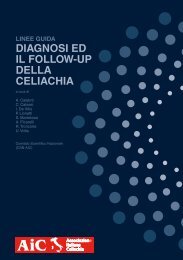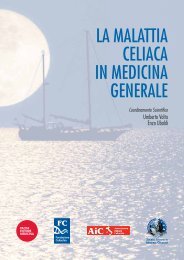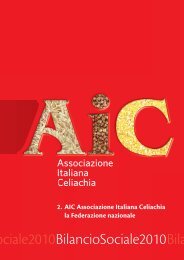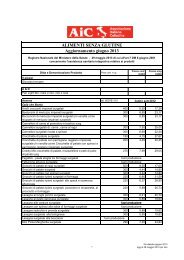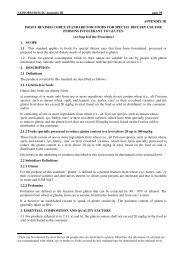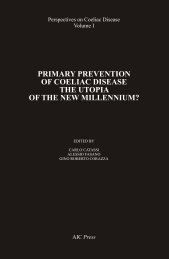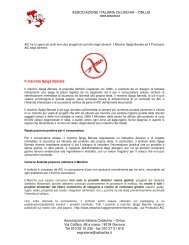Wheat Amylase Trypsin Inhibitors as Divers of Innate Immunity in ...
Wheat Amylase Trypsin Inhibitors as Divers of Innate Immunity in ...
Wheat Amylase Trypsin Inhibitors as Divers of Innate Immunity in ...
Create successful ePaper yourself
Turn your PDF publications into a flip-book with our unique Google optimized e-Paper software.
<strong>Wheat</strong> <strong>Amyl<strong>as</strong>e</strong> <strong>Tryps<strong>in</strong></strong> <strong>Inhibitors</strong> <strong>as</strong> <strong>Divers</strong> <strong>of</strong><br />
<strong>Innate</strong> <strong>Immunity</strong> <strong>in</strong> Celiac Dise<strong>as</strong>e<br />
Detlef Schuppan<br />
Pr<strong>of</strong>essor <strong>of</strong> Molecular and Translational Medic<strong>in</strong>e, Dept. Medic<strong>in</strong>e e I,<br />
Univ. <strong>of</strong> Ma<strong>in</strong>z, Germany<br />
Pr<strong>of</strong>essor <strong>of</strong> Medic<strong>in</strong>e, Division <strong>of</strong> G<strong>as</strong>troenterology, Beth Israel Deaconess<br />
Medical Center, Harvard Medical School, Boston, USA<br />
Associazione Italiana Celiachia, , Florence, March 29-31, 2012<br />
HARVARD<br />
MEDICAL<br />
SCHOOL
Hallmarks <strong>of</strong> celiac dise<strong>as</strong>e<br />
• Dietary gluten from wheat, barley, rye<br />
<strong>as</strong> trigger<br />
• Genetic Predisposition (HLA-DQ2 or –<br />
DQ8)<br />
• IgA autoantibodies to endomysium and<br />
reticul<strong>in</strong>
Def<strong>in</strong>ition <strong>of</strong> non-celiac gluten sensitivity<br />
Symptoms <strong>in</strong>duced by gluten <strong>in</strong>gestion <strong>in</strong> the<br />
absence <strong>of</strong> 1-3 <strong>of</strong> the 3 def<strong>in</strong><strong>in</strong>g hallmarks <strong>of</strong><br />
(adapative imunity )<strong>of</strong> celiac dise<strong>as</strong>e<br />
GS patients are orphans liv<strong>in</strong>g <strong>in</strong> a (diagnostic and<br />
therapeutic) no man‘s land
„gluten<br />
sensitivity“<br />
without DQ2/8 and<br />
celiac auto-Abs<br />
<br />
Verdu EF et al, Am J G<strong>as</strong>troenterol 2009
Role <strong>of</strong> the <strong>Innate</strong> Immune System <strong>in</strong> celiac dise<strong>as</strong>e – prior work<br />
• Stimulation <strong>of</strong> biopsies from CD patients with whole gliad<strong>in</strong> digests or α2<br />
gliad<strong>in</strong> p31-43 <strong>in</strong>cre<strong>as</strong>es the number <strong>of</strong> IL-15 positive cells with<strong>in</strong> the lam<strong>in</strong>a<br />
propria<br />
(Maiuri<br />
et al, Lancet 2003)<br />
• p31-43 <strong>in</strong>duces MICA on <strong>in</strong>test<strong>in</strong>al epithelial cells via IL-15, provid<strong>in</strong>g a target<br />
for cytotoxic IELs (Hue et al, <strong>Immunity</strong> 2004)<br />
• Peptic-tryptic<br />
tryptic gliad<strong>in</strong> digests and certa<strong>in</strong> gliad<strong>in</strong> peptides <strong>in</strong>duce activation<br />
and maturation <strong>of</strong> monocytes, , macrophages and dendritic cells (Tuckova<br />
Tuckova et al, J<br />
Leuk Biol 2002; Palova-Jel<strong>in</strong>kova<br />
et al, FEBS Lett 2004; Nikul<strong>in</strong>a et al, J Immunol 2004;<br />
Palova-Jel<strong>in</strong>kova<br />
et al. J Immunol., 2005; C<strong>in</strong>ova et al, J Cl<strong>in</strong> Immunol 2007; Rakhimova et al.,<br />
J Cl<strong>in</strong> Immunol 2008)<br />
• Gliad<strong>in</strong> <strong>in</strong>cre<strong>as</strong>es <strong>in</strong>test<strong>in</strong>al permeability and <strong>in</strong>duces DC activation via MyD88<br />
(implication <strong>of</strong> CXCR3 on <strong>in</strong>test<strong>in</strong>al epithelial cells <strong>as</strong> gliad<strong>in</strong> receptor) (Thom<strong>as</strong><br />
et al., J Immunol., 2006; Lammert et al, G<strong>as</strong>troenterology 2008)<br />
Problems:<br />
1. LPS contam<strong>in</strong>ation not strictly ruled out<br />
2. No reproducible identification <strong>of</strong> a certa<strong>in</strong> (set <strong>of</strong>) gliad<strong>in</strong> peptide(s)<br />
3. No receptor identified
The <strong>in</strong>nate immune<br />
response to gluten<br />
gliad<strong>in</strong><br />
PAMPs<br />
Major role <strong>of</strong> pr<strong>of</strong>essional<br />
APC <br />
Is it all gluten <br />
NKG2D (CD94)<br />
TCR+<br />
MIC-A/B<br />
HLA-E E NKG2A+ TCR+<br />
→ CTL suppression<br />
Bhagat G et al, JCI 2008<br />
NK-like<br />
IL-15<br />
IL-15<br />
CTL<br />
epithelial cell kill<strong>in</strong>g,<br />
apoptosis, permeability <br />
potentiation <strong>of</strong> the adaptive<br />
immune response to gluten<br />
TCR+<br />
CD8+<br />
<strong>in</strong>terferon , perfor<strong>in</strong><br />
granzyme, F<strong>as</strong>L<br />
IL-15:<br />
• central growth<br />
factor for<br />
<strong>in</strong>traepithelial NK<br />
cells and CTL<br />
• major driv<strong>in</strong>g force<br />
<strong>of</strong> clonal T cell<br />
expansion <strong>in</strong><br />
refractory sprue &<br />
<strong>in</strong>test<strong>in</strong>al T cell<br />
lymphoma<br />
Jabri B et al, G<strong>as</strong>troenterology 2000<br />
Maiuri L et al, Lancet 2003<br />
Hue S et al, <strong>Immunity</strong> 2004<br />
Meresse B et al, <strong>Immunity</strong> 2004<br />
Rakhimova M et al, J Cl<strong>in</strong> Immunol 2008
<strong>Wheat</strong> amyl<strong>as</strong>e-tryps<strong>in</strong><br />
<strong>in</strong>hibitors (ATIs)) <strong>as</strong> triggers <strong>of</strong> <strong>in</strong>nate immunity<br />
Junker Y et al, 2012<br />
HPLC purified extracted<br />
wheat ATI<br />
Oda Y et al, Biochemistry 1997
Purified ATI triggers <strong>in</strong>flammation via TLR4<br />
5 *<br />
4<br />
3<br />
Monocyte derived DCs<br />
*<br />
*<br />
*<br />
*<br />
3 wildtype<br />
C3H/HeJ<br />
2<br />
TLR4 wt and KO mice fed ATI<br />
2<br />
1<br />
*<br />
*<br />
1<br />
0<br />
0<br />
ATI 50g<br />
LPS and ATI: 2.5 nmol/ mouse<br />
C3H/HeJ: TLR4-/- due to a spontaneous<br />
po<strong>in</strong>t mutation<br />
Junker Y et al, 2011
Characteristics and functions <strong>of</strong> cereal ATIs<br />
• Mr 12-16<br />
16 kDa<br />
• 5 (4) highly conserved S-S bonds<br />
• Conserved 4 helix conformation<br />
• Hydrophobic <strong>in</strong>teraction sites<br />
• Form<strong>in</strong>g mono - tetramers<br />
• Highly resistant to (<strong>in</strong>test<strong>in</strong>al(<br />
<strong>in</strong>test<strong>in</strong>al) proteolysis<br />
Tatham and Shewry, Cl<strong>in</strong> Exp Allergy 2008
Characteristics and functions <strong>of</strong> cereal ATIs (2)<br />
• Up to 11 homologues <strong>in</strong> wheat (CM1-3, 16, 17,<br />
0.19, 0.28, 0.53……<br />
……)<br />
• Tetraploid encodes fewer than hxaploid wheat<br />
(lack <strong>of</strong> the D chromosome: : CM1, 3b, 7, 0.19, 0.28)<br />
• Pest control (<strong>in</strong>hibition<br />
<strong>of</strong> par<strong>as</strong>ite amyl<strong>as</strong>e and<br />
tryps<strong>in</strong> like activities)<br />
• Major wheat allergens (baker‘s <strong>as</strong>thma),<br />
food<br />
allergy to wheat and barley)<br />
Tatham and Shewry, Cl<strong>in</strong> Exp Allergy 2008
Allergen <strong>as</strong> TLR4 agonist<br />
2nd allergen<br />
Derp1……<br />
MD2<br />
TLR4<br />
MD2-mimetics:<br />
Derp2, ATI <br />
ATI <br />
Derp1<br />
Derp2<br />
from house<br />
dust mite<br />
CD23+<br />
IgE<br />
Allergy<br />
IL-4, IL-13<br />
Th2<br />
IL-6<br />
Rantes<br />
IRF3<br />
MCP-1<br />
IL-8<br />
TLR4 mediated potentiation<br />
<strong>of</strong> Th1 or allergic responses<br />
NFkB<br />
TNFα, , IL-12,<br />
IL-15<br />
Th1<br />
modified from<br />
Trompette A et al, Nature 2009<br />
Wills-Karp M et al, Mucosal Immunol 2010
Orig<strong>in</strong> <strong>of</strong> <strong>Wheat</strong><br />
Incre<strong>as</strong>e <strong>of</strong> content <strong>of</strong> immunogenic epitopes and ATI with higher ploidity
Celiac dise<strong>as</strong>e<br />
Cd is the best def<strong>in</strong>ed and most frequent <strong>in</strong>test<strong>in</strong>al (auto-)<br />
immune dise<strong>as</strong>e, with gluten (and ATI) <strong>as</strong> triggers, HLA-<br />
DQ2 (DQ8) <strong>as</strong> necessary genetic predisposition and TG2<br />
<strong>as</strong> patho-genetically<br />
l<strong>in</strong>ked autoantigen<br />
<br />
Most c<strong>as</strong>es are not <strong>as</strong>sociated with diarrhea or overt<br />
malabsorption, but are silent or atypical<br />
<br />
Dise<strong>as</strong>e severity depends on 1. gluten dose, 2. HLA-<br />
DQ2(DQ8)-gene dose, 3. <strong>in</strong>nate immunity (triggered<br />
by<br />
ATIs), , 4. 4<br />
. additional polygenetic and environmental factors<br />
<br />
<strong>Innate</strong> immunity to cereal ATI likely impacts other<br />
<strong>in</strong>test<strong>in</strong>al <strong>in</strong>flammatory dise<strong>as</strong>es


